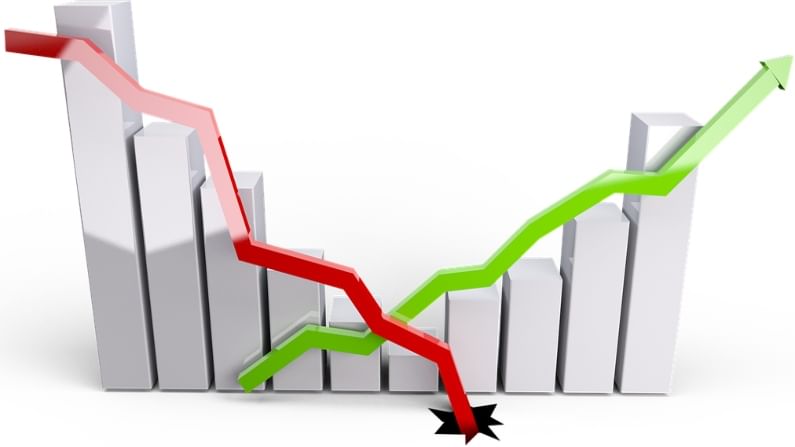Sensex slips 132 points, Nifty ends at 15,670 as RBI cuts FY22 GDP growth
Sensex was down 132 points or 0.25% at 52,100, whereas the Nifty 50 was down 20 points or 0.13% at 15,670 after hitting a lifetime high of 15,733

In a volatile session key benchmark indices ended in the red led by banking and financials stocks after the Reserve Bank of India (RBI) maintained the status quo and left the repo rate unchanged at 4%. While the stance remained accommodative the central bank cut India’s GDP growth forecast by one percentage point to 9.5%. At close, the key barometer index Sensex was down 132 points or 0.25% at 52,100, whereas the Nifty 50 was down 20 points or 0.13% at 15,670 after hitting a lifetime high of 15,733.
“The market had opened with mild positivity but pared the gains post announcement of RBI monetary policy. Factoring the impact of the second wave, RBI reduced the FY22 GDP forecast from 10.5% to 9.5% and trimmed the inflation forecast from 5.2% to 5.1%. As expected, RBI kept its policy rates unchanged and reiterated its accommodative stance. G-Sec buying and liquidity support to MSMEs and affected sectors will help to overcome the pandemic hit the economy,” said Vinod Nair, Head of Research at Geojit Financial Services
Gainer and losers
Bajaj Finserv, ONGC, L&T, Bajaj Finance, and HDFC gained the most on the Sensex rallying up to 2.5%. On the downside, Nestle India, SBI, HDFC Bank, ICICI Bank, and Axis Bank lost anywhere between 1-2%.
Buzzing sectors
Nifty Bank, Nifty Private Bank, Nifty PSU Bank & Nifty Financial Service indices ended in the red with losses upto 1%. On the other, the Nifty Metal index rallied 1.35%, Nifty Auto jumped 0.83%, Nifty Realty index rose 0.48% and Nifty IT ended with marginal gains of 0.03%.
Broader market
In the broader market, the BSE MidCap index advanced 0.63% while the BSE SmallCap index added 0.78% . Both the indices hit record peak levels of 22,540 and 24,280, respectively in intra-day trade.
Bharat Forge, Adani Enterprise, LIC Housing Finance, United Breweries & Castrol rallying over 5% on the BSE MidCap index. Where on the BSE SmallCap index HLV, Religare, Kiri Industries, Kaya and Maharashtra Bank jumped over 10%.
RBI policy outcome
The Reserve Bank of India (RBI) kept the policy repo rate unchanged at 4% while maintaining its accommodative stance after the conclusion of the Monetary Policy Committee (MPC) meeting today, 4 June 2021.
RBI’s MPC began its bi-monthly monetary policy deliberations on Wednesday, 2 June 2021. On the basis of an assessment of the current and evolving macroeconomic situation, the MPC at its meeting today (4 June 2021) decided to keep the policy repo rate under the liquidity adjustment facility (LAF) unchanged at 4%. Consequently, the reverse repo rate under the LAF remains unchanged at 3.35% and the marginal standing facility (MSF) rate and the Bank Rate at 4.25%.
The MPC also decided to continue with the accommodative stance as long as necessary to revive and sustain growth on a durable basis and continue to mitigate the impact of COVID-19 on the economy, while ensuring that inflation remains within the target going forward.
These decisions are in consonance with the objective of achieving the medium-term target for consumer price index (CPI) inflation of 4% within a band of +/- 2%, while supporting growth.
CPI inflation is projected at 5.1% during 2021-22: 5.2% in Q1; 5.4% in Q2; 4.7% in Q3; and 5.3% in Q4:2021-22; with risks broadly balanced. Real GDP growth is projected at 9.5% in 2021-22, consisting of 18.5% in Q1; 7.9% in Q2; 7.2% in Q3; and 6.6% in Q4:2021-22.
Global markets
Shares in Europe and Asia declined on Friday, following the U.S. equities that sagged amid robust economic data that stoked concerns about a pullback in central bank stimulus.
US stocks ended lower on Thursday, though they came off lows on signs President Joe Biden may be willing to compromise on corporate taxes.
Strong US jobs data and record service-sector growth underscored the recovery from the pandemic. The Institute for Supply Management said its services survey rose to a record 64% in May from 62.7% in April. Also Thursday, IHS Markit said its final U.S. services purchasing managers index reading came in at 70.4 in May, it’s the highest level since data began in 2009. A figure above 50 indicates growth inactivity.
Meanwhile, private-sector employment in the US jumped by 978,000 in May, according to the ADP National Economic Report.
Further, weekly data on applications for unemployment benefits also painted a positive picture for the labor market in the US. First-time claims for benefits fell to 385,000 last week, the first reading below 400,000 since the pandemic began.
Download Money9 App for the latest updates on Personal Finance.

